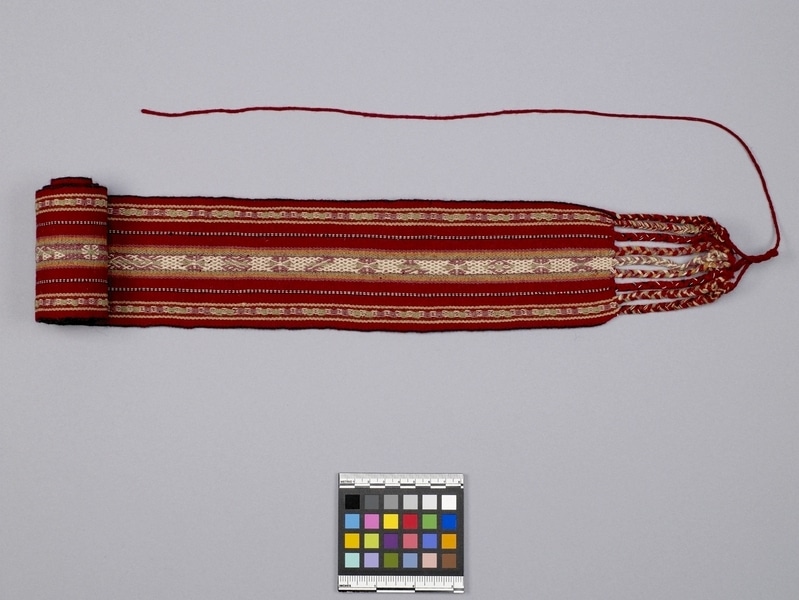Belt Item Number: Sf1010 from the MOA: University of British Columbia


Description
Belt with lengthwise bands containing geometric and figurative motifs. The central stripe is the widest and most elaborate containing 30 motifs of squares, diamonds, crosses, circles and birds worked in white against a background of purple and green. The flanking stripes are arranged symmetrically. The stripes nearest the edges are composed of white squares against a green and purple background. One end of the belt is finished with a braided fringe and yarn cords are attached at each end.
History Of Use
The techniques, structures and some of the motifs have pre-Conquest antecedents. This type of textile conveys the most about an individual's ethnicity, sex, age, status, and particular history. Belts like this are used by children and occasionally women in Taquile. Even more frequently today, they are woven for sale.
Iconographic Meaning
The range of motifs refers to local geography and landmarks, ecology, fecundity as well as luck. The six part circle refers to the division of land into six sections on Taquile and the rotation of crops and fallow periods.
Narrative
Bought in Cooperativo Artesnala Manco Capac, the cooperative textile store run by villagers on Taquile. A revival of natural dyeing is currently going on in Taquile. Sna. Leonarda from 'Antisuyu', a Lima cooperative that markets jungle crafts, came to Taquile and gave a workshop in 1987 on dyeing with cochineal (for red), chapi (a root of a bush, for burnt orange), chilca (tree leaves and flowers, for yellow and green), tule, cullu, and anil (indigo). Some families have enough natural dyed yarn to use in their weaving.
Specific Techniques
Commercial wool yarns, z spun and s plied are dyed with natural dyes and retwisted before warping. Warp-faced plain weave combined with a complementary warp pick-up weave (centre band) and a float weave (side bands). Warps in terminal area are braided in 3 strand oblique interlacing and cords made of re-plied yarn are attached at each end.
Item History
- Made in Taquile, Puno, Peru during 1987
- Collected by Mary Frame during 1987
- Owned by Mary Frame before November 3, 1987
- Received from Mary Frame (Seller) and Museum of Anthropology Shop Volunteers (Funding source) on November 3, 1987
What
- Name
- Belt
- Identification Number
- Sf1010
- Type of Item
- belt
- Material
- wool fibre, synthetic fibre and dye
- Manufacturing Technique
- retwisted, dyed, woven and braided
- Overall
- height 8.7 cm, width 102.0 cm
Who
- Culture
- Quechua
- Field Collector
- Mary Frame
- Previous Owner
- Mary Frame
- Received from
- Mary Frame (Seller) and Museum of Anthropology Shop Volunteers (Funding source)
Where
- Holding Institution
- MOA: University of British Columbia
- Made in
- Taquile, Puno, Peru
When
- Creation Date
- during 1987
- Collection Date
- during 1987
- Ownership Date
- before November 3, 1987
- Acquisition Date
- on November 3, 1987
Other
- Item Classes
- textiles
- Condition
- good
- Accession Number
- 1274/0029